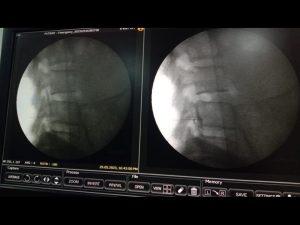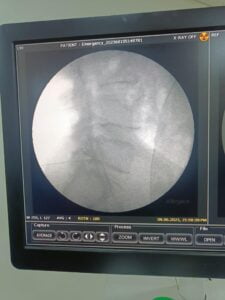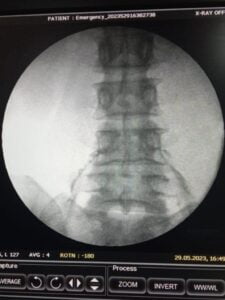What is Sciatica?
Sciatica also known as lumbar Radiculopathy is a common condition affecting the lower back causing pain, numbness, or tingling sensations along the course of the sciatic nerve. The sciatic nerve runs down from the lower back down through the buttocks and legs. Patients complain of sciatica when the sciatic nerve becomes compressed or irritated, leading to a range of uncomfortable symptoms. This can lead to significant disability, poor quality of life and result in more uptake of health resources as opposed to mechanical low back pain. Let’s look at the causes, symptoms, and treatment options for sciatica to help us develop a better understanding.
Risk factors
Personal factors
- Age (peak 45-64 years)
- Increasing risk with height
- Obesity
- Smoking
- Sedentary lifestyle
Occupational factors
- Strenuous physical activity—for example, frequent lifting, especially while bending and twisting
- Driving, including vibration of whole body
Common causes include
- Disc Herniation/Migration: A herniated or slipped disc is one of the most frequent causes of sciatica. When a disc in the spine bulges or ruptures, the advancing disc material(ie bulging nucleus pulpous) can impinge against the nerve roots that constitute the sciatic nerve leading to the symptoms.
- Spinal Stenosis: Spinal stenosis refers to the narrowing of the spinal canal, which can compress the nerves, including the sciatic nerve. This narrowing often occurs due to age-related degeneration or conditions such as osteoarthritis of the facet joints.
- Piriformis Syndrome: The piriformis muscle, located in the buttocks, can sometimes tighten or spasm, irritating the sciatic nerve as it passes beneath or through the muscle. This is known as piriformis syndrome.
- Spinal Injury or Trauma: Accidents, falls, or other traumatic events can cause damage to the spine, leading to inflammation and compression of the sciatic nerve.
Symptoms of Sciatica
The classical symptom of sciatica is pain that radiates from the lower back, through the buttocks, and down one leg and it is often associated with
- Sharp or Shooting Pain: The pain experienced in sciatica is often described as a sharp, burning, or electric shock-like sensation. It may be intermittent or constant, and its severity may vary.
- Numbness and Tingling: Along with pain, individuals with sciatica may experience numbness or tingling sensations in the buttocks, leg, or foot. This can range from a mild \”pins and needles\” sensation to complete numbness.
- Muscle Weakness: In some cases, sciatica can cause weakness in the affected leg, making it difficult to move or bear weight. Muscle weakness can affect daily activities such as walking or standing.
- Worsened Symptoms: Activities that involve prolonged sitting, standing, coughing, or sneezing may exacerbate sciatica symptoms, while lying down or walking may provide temporary relief.
Criteria for lumbar radicular pain
- Symptoms duration >4 weeks
- Unilateral leg pain radiating below the knee
- Leg pain worse than, or as bad as, back pain (if present)
- Positive straight leg raise test OR muscle weakness in one myotome OR loss of sensation in one dermatome
- No pain in contralateral leg below the gluteal margin
Treatment Options for Sciatica
- Conservative Management: Many cases of sciatica resolve with non-surgical treatments. These may include:
- Rest and Activity Modification: Avoiding activities that worsen pain and incorporating periods of rest can help reduce symptoms.
- Pain Medication: Over-the-counter pain relievers, such as nonsteroidal anti-inflammatory drugs (NSAIDs), can help alleviate pain and reduce inflammation.
- Heat or Ice Therapy: Applying heat or cold packs to the affected area can provide temporary relief from pain and inflammation.
- Physical Therapy: Targeted exercises and stretches can help improve flexibility, strengthen the back and core muscles, and alleviate pressure on the sciatic nerve.
- Epidural Steroid Injections (ESIs): In cases of severe or persistent pain, an ESI may be recommended. This procedure involves injecting a corticosteroid medication directly into the affected area to reduce inflammation and alleviate pain.
- Platelet Rich Plasma and Prolotherapy can also be undertaken in cases of sciatica due to degenerative disc disease to treat the arthritic facet joints and strengthen the ligament bone interface.
- Surgical Intervention: If conservative treatments do not provide relief or the underlying condition is severe, surgery may be considered. Common surgical options include discectomy (removal of a herniated disc). Microdiscectomy and Endoscopic discectomy are two common approaches for a majority of the surgical cases.



References
[1]. Konstantinou K, Hider SL, Jordan JL, et al. (2013) The impact of low back-related leg pain on outcomes as compared with low back pain alone: a systematic review of the literature. Clin J Pain 29(7):644–654, doi:10.1097/AJP.0b013e31826f9a52.CrossRefPubMedGoogle Scholar
[2]. Merskey H, Bogduk N (1994) Classification of chronic pain: Descriptions of chronic pain syndromes and definitions of pain terms (IASP Press, Seattle), 2nd edn.Google Scholar
[3]. Kongsted A, Kent P, Albert H, et al. (2012) Patients with low back pain differ from those who also have leg pain or signs of nerve root involvement — a cross-sectional study. BMC Musculoskelet Disord 13(1), doi:10.1186/1471-2474-13-236. 236.CrossRefPubMedGoogle Scholar





